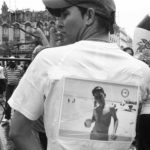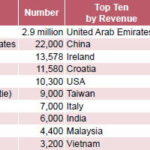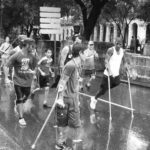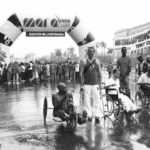Photo credit C Gorry
Cuba and Cancer
Cubans have more than enough reasons to turn out for the Run. As the number two cause of death and the first cause of years of potential life lost of people under age 75, cancer is among Cuba’s most pressing health problems; in recent years, cancer has accounted for an average loss of 12.7-16.9 years of life per 1,000 population in that age group. Coupled with the fact that 42% of malignant tumors in Cuba are preventable, 30% are treatable, and deaths from malignant tumors have steadily risen since 1970 (Table 1),[2] it’s no surprise that health authorities on the island are focusing heavily on cancer prevention and treatment. In an effort to combat the growing problem, policy makers have taken the same integrated, intersectoral approach that has shown such positive results in other areas of Cuban public health, including infant mortality, tropical disease eradication, and equitable access.
As always, establishing the scope of the problem was among the first steps. To this end, the National Cancer Registry was founded in 1987. A data collection instrument used to capture statistics of all cancers according to a cross-section of variables (e.g., age, location, gender, etc.), the Registry is used by the National Cancer Control Unit and the National Oncology Group to design prevention, diagnostic, treatment, and research policies for the country’s public health system. Despite the utility of such a registry for quantifying cancer prevalence and incidence, Cuba is one of the few countries to employ a registry of national scope. Once the nature and size of the problem were better understood, other mechanisms underpinning the Cuban public health strategy were implemented; these included developing biotechnology capability for cancer vaccines and therapies, equipping specialist services, and mounting a cancer-specific prevention and health promotion program with evidence-based research at its core.
A Shared Vision, a Shared Cause
“Cancer doesn’t discriminate against, age, gender, color, culture, or creed, and we need as many cancer researchers working on all types of cancers as possible. It truly doesn’t matter where the cure is found. What matters is that the dream that Terry started…will be realized, that we will all live in a world free of cancer,” Judith Fox-Alder, International Director of The Terry Fox Foundation told MEDICC Review in an exclusive interview.
Diagnosed with osteogenic sarcoma (bone cancer) in his right leg at the age of 18, Terry’s dream of running to cure cancer was born on the eve of his amputation. Reading about the achievements of a one-legged runner, Terry took his valiant but improbable idea into the operating room where his right leg was amputated six inches above the knee. While recovering, he drummed up support for his cause, writing to the Canadian Cancer Society, “I’m not a dreamer, and I’m not saying this will initiate any kind of definitive answer or cure to cancer, but I believe in miracles. I have to…people in cancer clinics all over the world need people who believe in miracles.”[3] After training for over a year by running a miraculous 3,107 miles with a prosthetic leg,[4] Terry was ready to convert his dream to reality. On April 12, 1980, accompanied by Doug Alward- his driver, trainer, and support team rolled into one-Terry Fox dipped his artificial leg in the Atlantic Ocean off Newfoundland and started running west. He didn’t stop for 143 days, running 26 miles a day, raising awareness and money for cancer research. On September 1 of that year, Terry was forced to stop about halfway to his cross-country goal, but declared “I’ll fight. I promise I won’t give up.”[4] Terry Fox died on June 28, 1981, but his dream lives on in the form of the Terry Fox Run, now held in 29 countries around the world.
Table 1: Deaths from Malignant Tumors in Cuba, 1970-2007

*Provisional †Per 100,000 population
Source: Anuario Estadístico de Salud 2007. Ministry of Public Health. 2008: Havana.
Heroic, inspiring, and courageous are the words most often used to describe Terry’s extraordinary feat. But how does such a show of strength and character, played out decades ago in a different country and culture, resonate today on a small Caribbean island thousands of miles away? “In Cuba, the Terry Fox Foundation found fertile ground in which to plant a seed,” Dr Teresa Romero, Director of the National Cancer Control Unit and co-organizer of the Run, told MEDICC Review. “We’re accustomed to adopting foreigners with whom we share a vision….We have an affinity for, and solidarity with, the cause of cancer research, evidenced in Cuba’s massive participation.” Massive participation indeed: since 500 athletes, cancer survivors, and supporters participated in the first Terry Fox Run in Havana in 1998, the Cuban version of the event-held island-wide since 2003-has grown to the biggest outside of Canada (see Table 2).

“Children all over the world need more cancer research,” said Juan Osmany, who ran in memory of his son Juan Pablo.
Photo credit C Gorry
The 2009 Terry Fox Run in Cuba
The 11th Terry Fox Run Against Cancer, celebrated March 21, 2009, in each of the 169 municipalities across Cuba, once again saw Cubans taking to the streets to support cancer research. Organized by the Cuban ministries of health, culture, and foreign relations; the National Sports and Recreation Institute; the National Cancer Control Unit; and the Canadian Embassy; the Run “is a great way to sensitize the Cuban population to the problem…and to show that yes, we can fight cancer,” says Jean-Pierre Juneau, Canadian Ambassador to the island nation. “It also gives us an opportunity to collaborate with Cuban colleagues and organizers to keep the spirit of Terry alive,” he continued. That spirit was both alive and well in Havana at this year’s run, where Cubans in wheelchairs and on bikes, wearing sneakers and flip flops, set out under grey skies and unseasonable rains to fight cancer.
Table 2: Top Ten Countries in Terry Fox Run by Participants and Revenue (2008)

Source: The Terry Fox Foundation International Newsletter. 2008.
“I’m running because I have many friends and family who are sick or who’ve died of cancer,” participant Xenia Reloba told MEDICC Review after crossing the finish line. “The Terry Fox Run is a way to lend my support and affirm that we can fight cancer.” Wendy Chaguaceda expressed similar sentiments as she approached the end of the three kilometer route, raindrops falling from the pink ribbon pinned to her shirt. “I’ve run several years in a row to show my solidarity with people with cancer. Come on, let’s go!” she said, encouraging her running partners and the people around her-including several young amputees on crutches-towards the finish line.
In addition to survivors, families, and supporters, 2009 Run participants included cancer specialists from Havana City’s 82 community-based polyclinics, the mainstay of universal primary care for the capital’s 2.2 million people. “Eventually every polyclinic will have a specialized cancer unit offering early detection services for all types of cancer. For women in particular, these will include how-to information on breast self-exams, plus psychological support and sexual health workshops for cancer survivors and their families,” Dr Eva Elena Salomon, Director of the Havana City Provincial Cancer Observatory, told MEDICC Review as she finished the race.
The program is already underway in many of the city’s polyclinics, with 145 family doctors having completed coursework for accreditation in community oncology, Dr Salomon explained.
From Finish Line to Bottom Line
Unlike participants in some other countries, runners in Cuba’s Marathon of Hope don’t collect donations from sponsors. How, then, does a small, poor country like Cuba raise funds for cancer research, and where does the money go?

A Canadian volunteer collects money at Havana’s Terry Fox Marathon of Hope.
Photo credit C Gorry
First, individuals can donate to the cause by depositing funds in a dedicated bank account (see Box 1), and volunteers “pass the hat” during the nationwide Run. Additionally, “the Canadian Embassy, in collaboration with the Cuban Ministry of Culture, hosts an art auction coinciding with the Terry Fox Run each year,” Raquel de los Reyes of the Canadian Embassy in Cuba told MEDICC Review. “The artwork is donated by the artists, and proceeds benefit cancer research programs.” Despite economic constraints, the Cuban government prioritizes such programs, which have resulted in innovative cancer vaccines and therapies.[5,6] Money raised in Cuba from the Terry Fox Run, together with these government funds, supports cancer research undertaken by the country’s National Institute of Oncology and Radiobiology (INOR).
According to Dr Rolando Camacho, Director of the National Oncology Group, the primary purpose of the Run is to promote cancer research, though complementary goals of highlighting prevention and changing the Cuban public’s perception of cancer are also promoted by the event. Five cancer studies using Run funds have been approved by the National Oncology Group in scientific consultation with Canadian specialists; to date, two of these studies have been completed. The first identified potential genetic markers for breast cancer among a representative group of families.
This is the first step towards implementing a national registry of families with a history of breast cancer. It is worth noting that breast cancer is currently the most prevalent of all malignancies in Cuban women, and deaths from breast cancer have risen steadily since 1970 (see Table 3).[7]
Table 3: Breast Cancer Mortality in Cuba, 1970-2007

*Provisional †Per 100,000 female population
Source: Anuario Estadístico de Salud 2007. Ministry of Public Health. 2008: Havana.
The second study completed with Terry Fox Run funds involved development of a highly specific test for detecting human papilloma virus linked to cervical cancer. As the test becomes available in public health laboratories throughout the island, diagnoses can be made sooner, faster and ever more accurately.
Among the studies earmarked for 2009 Run funds are a breast cancer case-control study to determine risk factors for breast cancer, and a study measuring patient response to different cancer treatments.
From Canada to Cuba and all around the globe, cancer research has come a long way thanks to one young man’s valiant, improbable dream. Ms. Fox-Alder of The Terry Fox Foundation, summed up why the Run has such resonance: “Terry was an ordinary young man who sacrificed so much to help the plight of others. His story of courage and perseverance teaches us that anything is possible if we try and that one person truly can make a difference in our world.” For over a decade, millions of Cubans have been proving her right.

Despite slick streets and grey skies, the spirit of Terry Fox lived on at this year’s Run in Havana.
Photo credit C Gorry








